NT
-
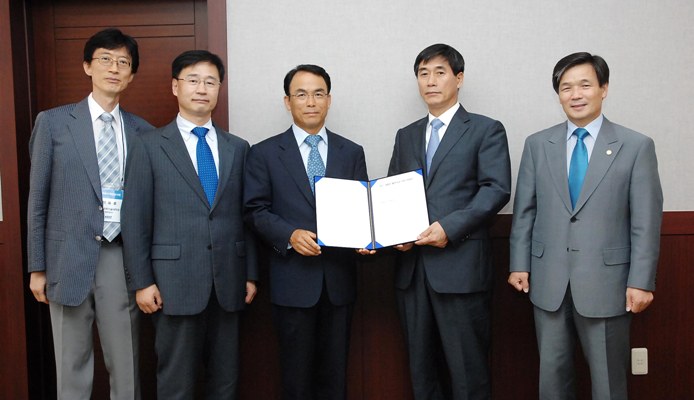 Former Minister of Information & Communications Dae-Je Jin donated to KAIST.
From left to right: Yong-Hoo Lee, Dean of Information Science & Technology College, KAIST; Gang-Seok Lee, Vice President of Skylake Incuvest, Inc.; Dae-Je Jin, Former Minister of Information & Communications; Byung-Kyu Choi, Provost of KAIST; and Dae-Joon Joo, Vice President of Planning & Budget, KAIST.
Mr. Dae-Je Jin, who had served as the Minister of Information & Communications, South Korea, gave away about 100,000 USD to KAIST and hoped that his donation would be used for the development of information and technology industry in the nation.
Mr. Jin, widely known as one of the reputable business leaders in the IT industry, was also once the president of Samsung Electronics, a leading global supplier of electronic products and goods. Currently, he runs a private equity investor called, Skylake Incuvest, Inc., which invests and incubates innovative information, communications, and technology companies.
“The real growth engine for our nation to become an economic powerhouse on a global stage has been the highly trained people who shore up our industry. Universities including KAIST have played an excellent role in providing our nation with such outstanding researchers and engineers. I will continue to support for KAIST"s mission as a leading research university in science and technology in Korea and the world,” said Mr. Jin.
KAIST said that his donation would be used for the support of its IT researches.
2010.08.27 View 14053
Former Minister of Information & Communications Dae-Je Jin donated to KAIST.
From left to right: Yong-Hoo Lee, Dean of Information Science & Technology College, KAIST; Gang-Seok Lee, Vice President of Skylake Incuvest, Inc.; Dae-Je Jin, Former Minister of Information & Communications; Byung-Kyu Choi, Provost of KAIST; and Dae-Joon Joo, Vice President of Planning & Budget, KAIST.
Mr. Dae-Je Jin, who had served as the Minister of Information & Communications, South Korea, gave away about 100,000 USD to KAIST and hoped that his donation would be used for the development of information and technology industry in the nation.
Mr. Jin, widely known as one of the reputable business leaders in the IT industry, was also once the president of Samsung Electronics, a leading global supplier of electronic products and goods. Currently, he runs a private equity investor called, Skylake Incuvest, Inc., which invests and incubates innovative information, communications, and technology companies.
“The real growth engine for our nation to become an economic powerhouse on a global stage has been the highly trained people who shore up our industry. Universities including KAIST have played an excellent role in providing our nation with such outstanding researchers and engineers. I will continue to support for KAIST"s mission as a leading research university in science and technology in Korea and the world,” said Mr. Jin.
KAIST said that his donation would be used for the support of its IT researches.
2010.08.27 View 14053 -
 South Koreans Develop High-Performance Software Router.
HPC Wire, covering news on computing software, hardware, networking, storage, tools and applications, published an article on the development of high-performance router by a KAIST research team.
The research team consisted of the Departments of Computer Science and Electrical Engineering, KAIST, presented PacketShader, a high-performance software router framework for general packet processing with Graphics Processing Unit (GPU) acceleration. PacketShader, the research team said, that exploits the massively-parallel processing power of GPU to address the CPU bottleneck in current software routers.
For the article, please click the link: http://www.hpcwire.com/news/South-Koreans-Develop-High-Performance-Software-Router-101401434.html
2010.08.25 View 13479
South Koreans Develop High-Performance Software Router.
HPC Wire, covering news on computing software, hardware, networking, storage, tools and applications, published an article on the development of high-performance router by a KAIST research team.
The research team consisted of the Departments of Computer Science and Electrical Engineering, KAIST, presented PacketShader, a high-performance software router framework for general packet processing with Graphics Processing Unit (GPU) acceleration. PacketShader, the research team said, that exploits the massively-parallel processing power of GPU to address the CPU bottleneck in current software routers.
For the article, please click the link: http://www.hpcwire.com/news/South-Koreans-Develop-High-Performance-Software-Router-101401434.html
2010.08.25 View 13479 -
 KAIST hosts training program for Indian MBA students
The College of Business of KAIST held an academic exchange program, inviting MBA students from the Indian Institute of Management. 65 students from India visited Korea and would have a two-week training course including field trips to various companies in the nation. For details, please click the link of Arirang News broadcasted on August 19, 2010.
http://www.arirang.co.kr/News/News_View.asp?nseq=106066&code=Ne2&category=2
2010.08.20 View 11360
KAIST hosts training program for Indian MBA students
The College of Business of KAIST held an academic exchange program, inviting MBA students from the Indian Institute of Management. 65 students from India visited Korea and would have a two-week training course including field trips to various companies in the nation. For details, please click the link of Arirang News broadcasted on August 19, 2010.
http://www.arirang.co.kr/News/News_View.asp?nseq=106066&code=Ne2&category=2
2010.08.20 View 11360 -
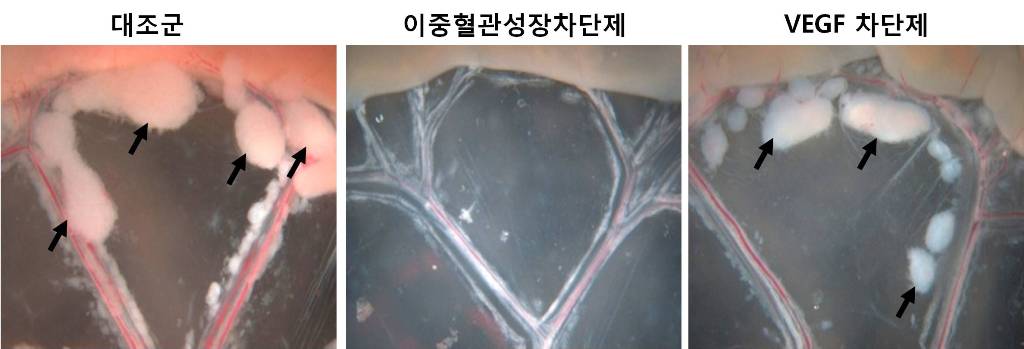 An internationally renowned academic journal published the research result produced by a KAST research team on its cover.
Fc DAAP VEGF-Trap
Photograph showing the gross features of tumor growth along the mesentery-intestinal border. T: tumor. Scale bars represent 5 mm.
Professor Gou-Young Koh of the Biological Sciences Department, KAIST, and his research team published their research result in Cancer Cell, a peer-review scientific journal, as a cover article dated August 17, 2010. It is the first time for the journal to pick up a paper written by a Korean research team and publish it as the cover.
It has been known that a vascular growth factor (VEGF) is closely related to the growth of a tumor. The research team recently discovered that in addition to VEGF, another growth factor, angiopoietin-2 (Ang2), is also engaged with the increase of tumors.
Professor Koh said, “VEGF and the angiopoietins play critical roles in tumor progression and metastasis, and a single inhibitor targeting both factors have not been available.”
The team led by Professor Koh has developed a double anti-angiogenic protein (DAAP) that can simultaneously bind VEGF-A and the angiopoietins and block their actions.
Professor Koh said in his paper, “DAAP is a highly effective molecule for regressing tumor angiogenesis and metastasis in implanted and spontaneous solid tumor; it can also effectively reduce ascites formation and vascular leakage in an ovarian carcinoma model. Thus, simultaneous blockade of VEGF-A and angiopoietins with DAAP is an effective therapeutic strategy for blocking tumor angiogenesis, metastasis, and vascular leakage.”
So far, cancer patients have received Avastin, anticancer drug, to inhibit VEGF, but the drug has not successfully restrained the growth of cancer tumors and brought to some of the patients with serious side effects instead.
Professor Koh said, “DAAP will be very effective to control the expansion of tumor growth factors, which will open up a new possibility for the development of more helpful cancer medicine with low side effects.”
2010.08.20 View 14915
An internationally renowned academic journal published the research result produced by a KAST research team on its cover.
Fc DAAP VEGF-Trap
Photograph showing the gross features of tumor growth along the mesentery-intestinal border. T: tumor. Scale bars represent 5 mm.
Professor Gou-Young Koh of the Biological Sciences Department, KAIST, and his research team published their research result in Cancer Cell, a peer-review scientific journal, as a cover article dated August 17, 2010. It is the first time for the journal to pick up a paper written by a Korean research team and publish it as the cover.
It has been known that a vascular growth factor (VEGF) is closely related to the growth of a tumor. The research team recently discovered that in addition to VEGF, another growth factor, angiopoietin-2 (Ang2), is also engaged with the increase of tumors.
Professor Koh said, “VEGF and the angiopoietins play critical roles in tumor progression and metastasis, and a single inhibitor targeting both factors have not been available.”
The team led by Professor Koh has developed a double anti-angiogenic protein (DAAP) that can simultaneously bind VEGF-A and the angiopoietins and block their actions.
Professor Koh said in his paper, “DAAP is a highly effective molecule for regressing tumor angiogenesis and metastasis in implanted and spontaneous solid tumor; it can also effectively reduce ascites formation and vascular leakage in an ovarian carcinoma model. Thus, simultaneous blockade of VEGF-A and angiopoietins with DAAP is an effective therapeutic strategy for blocking tumor angiogenesis, metastasis, and vascular leakage.”
So far, cancer patients have received Avastin, anticancer drug, to inhibit VEGF, but the drug has not successfully restrained the growth of cancer tumors and brought to some of the patients with serious side effects instead.
Professor Koh said, “DAAP will be very effective to control the expansion of tumor growth factors, which will open up a new possibility for the development of more helpful cancer medicine with low side effects.”
2010.08.20 View 14915 -
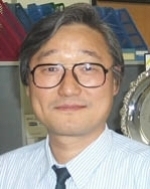 Nature Photonics, a peer-reviewed scientific journal, released a paper written by a KAIST research team on the time-of-flight measurement.
Professor Seung-Woo Kim of the Mechanical Engineering Department, KAIST, and his research team published the result of their study on the measurement of 1 nanometer (nm) precision.
“The time-of-flight of light pulses has long been used as a direct measure of distance, but state-of-the-art measurement precision using conventional light pulses or microwaves peaks at only several hundreds of micrometers. Here, we improve the time-of-flight precision to the nanometer regime by timing femtosecond pulses through phase-locking control of the pulse repetition rate using the optical cross-correlation technique,” Professor Kim said.
According to the experiment conducted by the research team, “An Allan deviation of 117 nm in measuring a 700m distance in air at a sampling rate of 5 millisecond (ms) once the pulse repetition is phased-locked, which reduces to 7 nm as the averaging time increases to 1 second (s).”
When measuring an object located in a far distance, a laser beam is projected to the object, and the reflected light is analyzed; the light is then converted into an electric signal to calculate the distance. In so doing, Professor Kim said, the conventional method of measurement creates at least 1 mm of deviation.
He argues, “This enhanced capability is maintained at long range without periodic ambiguity, and is well suited to lidar applications. This method could also be applied to future space missions involving formation-flying satellites for synthetic aperture imaging and remote experiments related to general relativity theory."
Nature Photonics published the article online on August 8, 2010.
2010.08.18 View 15519
Nature Photonics, a peer-reviewed scientific journal, released a paper written by a KAIST research team on the time-of-flight measurement.
Professor Seung-Woo Kim of the Mechanical Engineering Department, KAIST, and his research team published the result of their study on the measurement of 1 nanometer (nm) precision.
“The time-of-flight of light pulses has long been used as a direct measure of distance, but state-of-the-art measurement precision using conventional light pulses or microwaves peaks at only several hundreds of micrometers. Here, we improve the time-of-flight precision to the nanometer regime by timing femtosecond pulses through phase-locking control of the pulse repetition rate using the optical cross-correlation technique,” Professor Kim said.
According to the experiment conducted by the research team, “An Allan deviation of 117 nm in measuring a 700m distance in air at a sampling rate of 5 millisecond (ms) once the pulse repetition is phased-locked, which reduces to 7 nm as the averaging time increases to 1 second (s).”
When measuring an object located in a far distance, a laser beam is projected to the object, and the reflected light is analyzed; the light is then converted into an electric signal to calculate the distance. In so doing, Professor Kim said, the conventional method of measurement creates at least 1 mm of deviation.
He argues, “This enhanced capability is maintained at long range without periodic ambiguity, and is well suited to lidar applications. This method could also be applied to future space missions involving formation-flying satellites for synthetic aperture imaging and remote experiments related to general relativity theory."
Nature Photonics published the article online on August 8, 2010.
2010.08.18 View 15519 -
 KAIST has developed a powerless and wireless keyboard that can be folded and easily carried around.
The KAIST Institute for Information Technology Convergence (KIITC) has developed the next generation keyboard that does not need power and wires.
The powerless/wireless keyboard developed by KIITC is flexible, foldable, portable, and compact, making the possession of keyboard easier and more convenient.
The idea of this technology was derived from "Idea Contest for Future Device" opened by KIITC in 2007, and Future Device Team (Team Leader: Dr. Sungkwan Jung) of KIITC embodied the idea and developed full-flexible powerless/wireless keyboard by using the passive Radio Frequency Identification (RFID) technology to support the convenient data input for daily mobile life.
Through the technology, KAIST expects to realize ubiquitous computing and communication environment, open a new market for foldable keyboards, and secure the competitiveness of mobile devices industries in the world market.
KIITC has also successfully transferred the technology of powerless/wireless keyboard to Hanyang Demitech for commercialization.
2010.08.12 View 15289
KAIST has developed a powerless and wireless keyboard that can be folded and easily carried around.
The KAIST Institute for Information Technology Convergence (KIITC) has developed the next generation keyboard that does not need power and wires.
The powerless/wireless keyboard developed by KIITC is flexible, foldable, portable, and compact, making the possession of keyboard easier and more convenient.
The idea of this technology was derived from "Idea Contest for Future Device" opened by KIITC in 2007, and Future Device Team (Team Leader: Dr. Sungkwan Jung) of KIITC embodied the idea and developed full-flexible powerless/wireless keyboard by using the passive Radio Frequency Identification (RFID) technology to support the convenient data input for daily mobile life.
Through the technology, KAIST expects to realize ubiquitous computing and communication environment, open a new market for foldable keyboards, and secure the competitiveness of mobile devices industries in the world market.
KIITC has also successfully transferred the technology of powerless/wireless keyboard to Hanyang Demitech for commercialization.
2010.08.12 View 15289 -
 A graduate-level education for working professionals in science programs and exhibitions will be available from mid-August this year.
The Graduate School of Culture Technology (GSCT), KAIST, has created a new course for professionals who purse their career in science programs and exhibitions, which will start on August 19 and continue through the end of November 2010. The course will be held at Digital Media City in Seoul.
The course, also co-sponsored by National Science Museum, will offer students tuition-free opportunities to brush up their knowledge on the administration, policy, culture, technology, planning, contents development, and technology & design development, of science programs and exhibitions. Such subjects as science contents, interaction exhibitions, and utilization of new media will be studied and discussed during the course. Students will also have a class that is interactive, engaging, and visual, as well as provides hands-on learning activities.
A total of 30 candidates will be chosen for the course. Eligible applicants are graduates with a B.S. degree in the relevant filed, science program designers and exhibitors, curators for science and engineering museums, and policy planners for public and private science development programs.
2010.08.12 View 15580
A graduate-level education for working professionals in science programs and exhibitions will be available from mid-August this year.
The Graduate School of Culture Technology (GSCT), KAIST, has created a new course for professionals who purse their career in science programs and exhibitions, which will start on August 19 and continue through the end of November 2010. The course will be held at Digital Media City in Seoul.
The course, also co-sponsored by National Science Museum, will offer students tuition-free opportunities to brush up their knowledge on the administration, policy, culture, technology, planning, contents development, and technology & design development, of science programs and exhibitions. Such subjects as science contents, interaction exhibitions, and utilization of new media will be studied and discussed during the course. Students will also have a class that is interactive, engaging, and visual, as well as provides hands-on learning activities.
A total of 30 candidates will be chosen for the course. Eligible applicants are graduates with a B.S. degree in the relevant filed, science program designers and exhibitors, curators for science and engineering museums, and policy planners for public and private science development programs.
2010.08.12 View 15580 -
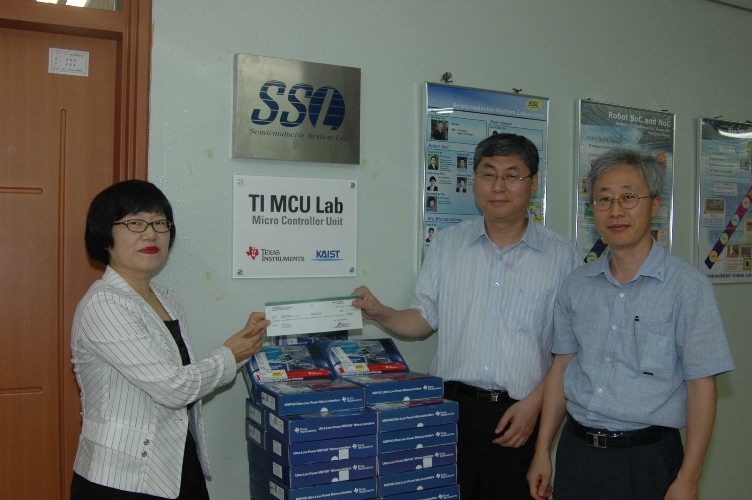 Texas Instruments, Inc. Agreed for Collaborative Research with Professor Hai-Joon Yoo, the Electrical Engineering Department of KAIST
Professor Hai-Joon Yoo from the Electrical Engineering Department of KAIST made a research collaboration agreement with Texas Instruments (TI), Inc. in July 2010 to develop a “Many-core Processor Chip,” a chip that is designed to emulate a human brain.
TI, Inc. is an American company based in Dallas, Texas and renowned for developing and commercializing semiconductor and computer technology. The company is the 4th largest manufacturer of semiconductors worldwide, 2nd supplier of chips for cellular handsets, and 1st producer of digital signal processors and analog semiconductors, among a wide range of semiconductor products.
TI, Inc. has designated Professor Yoo’s lab as one of its official labs and promised to give financial supports for the lab—it has pledged to donate a total value of 300 million won of research fund and equipment to Professor Yoo. On July 21, 2010, the signboard hanging ceremony for the designation of a TI Lab was held at Professor Yoo’s lab.
Professor Yoo developed a neuro-circuit network to emulate a human brain by adopting a mixed mode circuit that has chips for analog and digital circuits. He then has conducted a research to graft the mixed mode circuit onto a Many-core Processor to integrate the human intelligence into a conventional single-core processor that can process one instruction at a time. The Many-core Processor, once developed, can be applied to various kinds of products such as an artificial intelligence surveillance camera, robot, smart car, and the like.
Professor Yoo has presented his research results at numerous international meetings and conferences, among other things, the International Solid-State Circuits Conference (ISSCC), a global forum sponsored by the Institute of Electrical and Electronics Engineers (IEEE) for presentation of advances in solid-state circuits and Systems-on-a-Chip. The Conference offers a unique opportunity for engineers working at the cutting edge of IC design to maintain technical currency, and to network with leading experts.
Professor Yoo is a senior member of IEEE and Chairman of ISSCC in Asia.
2010.08.05 View 15354
Texas Instruments, Inc. Agreed for Collaborative Research with Professor Hai-Joon Yoo, the Electrical Engineering Department of KAIST
Professor Hai-Joon Yoo from the Electrical Engineering Department of KAIST made a research collaboration agreement with Texas Instruments (TI), Inc. in July 2010 to develop a “Many-core Processor Chip,” a chip that is designed to emulate a human brain.
TI, Inc. is an American company based in Dallas, Texas and renowned for developing and commercializing semiconductor and computer technology. The company is the 4th largest manufacturer of semiconductors worldwide, 2nd supplier of chips for cellular handsets, and 1st producer of digital signal processors and analog semiconductors, among a wide range of semiconductor products.
TI, Inc. has designated Professor Yoo’s lab as one of its official labs and promised to give financial supports for the lab—it has pledged to donate a total value of 300 million won of research fund and equipment to Professor Yoo. On July 21, 2010, the signboard hanging ceremony for the designation of a TI Lab was held at Professor Yoo’s lab.
Professor Yoo developed a neuro-circuit network to emulate a human brain by adopting a mixed mode circuit that has chips for analog and digital circuits. He then has conducted a research to graft the mixed mode circuit onto a Many-core Processor to integrate the human intelligence into a conventional single-core processor that can process one instruction at a time. The Many-core Processor, once developed, can be applied to various kinds of products such as an artificial intelligence surveillance camera, robot, smart car, and the like.
Professor Yoo has presented his research results at numerous international meetings and conferences, among other things, the International Solid-State Circuits Conference (ISSCC), a global forum sponsored by the Institute of Electrical and Electronics Engineers (IEEE) for presentation of advances in solid-state circuits and Systems-on-a-Chip. The Conference offers a unique opportunity for engineers working at the cutting edge of IC design to maintain technical currency, and to network with leading experts.
Professor Yoo is a senior member of IEEE and Chairman of ISSCC in Asia.
2010.08.05 View 15354 -
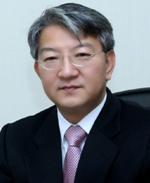 Bioengineers develop a new strategy for accurate prediction of cellular metabolic fluxes
A team of pioneering South Korean scientists has developed a new strategy for accurately predicting cellular metabolic fluxes under various genotypic and environmental conditions. This groundbreaking research is published in the journal Proceedings of the National Academy of Sciences of the USA (PNAS) on August 2, 2010.
To understand cellular metabolism and predict its metabolic capability at systems-level, systems biological analysis by modeling and simulation of metabolic network plays an important role. The team from the Korea Advanced Institute of Science and Technology (KAIST), led by Distinguished Professor Sang Yup Lee, focused their research on the development of a new strategy for more accurate prediction of cellular metabolism.
“For strain improvement, biologists have made every effort to understand the global picture of biological systems and investigate the changes of all metabolic fluxes of the system under changing genotypic and environmental conditions,” said Lee. The accumulation of omics data, including genome, transcriptome, proteome, metabolome, and fluxome, provides an opportunity to understand the cellular physiology and metabolic characteristics at systems-level. With the availability of the fully annotated genome sequence, the genome-scale in silico (means “performed on computer or via computer simulation.”) metabolic models for a number of organisms have been successfully developed to improve our understanding on these biological systems. With these advances, the development of new simulation methods to analyze and integrate systematically large amounts of biological data and predict cellular metabolic capability for systems biological analysis is important.
Information used to reconstruct the genome-scale in silico cell is not yet complete, which can make the simulation results different from the physiological performances of the real cell. Thus, additional information and procedures, such as providing additional constraints (constraint: a term to exclude incorrect metabolic fluxes by restricting the solution space of in silico cell) to the model, are often incorporated to improve the accuracy of the in silico cell.
By employing information generated from the genome sequence and annotation, the KAIST team developed a new set of constraints, called Grouping Reaction (GR) constraints, to accurately predict metabolic fluxes. Based on the genomic information, functionally related reactions were organized into different groups. These groups were considered for the generation of GR constraints, as condition- and objective function- independent constraints. Since the method developed in this study does not require complex information but only the genome sequence and annotation, this strategy can be applied to any organism with a completely annotated genome sequence.
“As we become increasingly concerned with environmental problems and the limits of fossil resources, bio-based production of chemicals from renewable biomass has been receiving great attention. Systems biological analysis by modeling and simulation of biological systems, to understand cellular metabolism and identify the targets for the strain improvement, has provided a new paradigm for developing successful bioprocesses,” concluded Lee. This new strategy for predicting cellular metabolism is expected to contribute to more accurate determination of cellular metabolic characteristics, and consequently to the development of metabolic engineering strategies for the efficient production of important industrial products and identification of new drug targets in pathogens.”
2010.08.05 View 17670
Bioengineers develop a new strategy for accurate prediction of cellular metabolic fluxes
A team of pioneering South Korean scientists has developed a new strategy for accurately predicting cellular metabolic fluxes under various genotypic and environmental conditions. This groundbreaking research is published in the journal Proceedings of the National Academy of Sciences of the USA (PNAS) on August 2, 2010.
To understand cellular metabolism and predict its metabolic capability at systems-level, systems biological analysis by modeling and simulation of metabolic network plays an important role. The team from the Korea Advanced Institute of Science and Technology (KAIST), led by Distinguished Professor Sang Yup Lee, focused their research on the development of a new strategy for more accurate prediction of cellular metabolism.
“For strain improvement, biologists have made every effort to understand the global picture of biological systems and investigate the changes of all metabolic fluxes of the system under changing genotypic and environmental conditions,” said Lee. The accumulation of omics data, including genome, transcriptome, proteome, metabolome, and fluxome, provides an opportunity to understand the cellular physiology and metabolic characteristics at systems-level. With the availability of the fully annotated genome sequence, the genome-scale in silico (means “performed on computer or via computer simulation.”) metabolic models for a number of organisms have been successfully developed to improve our understanding on these biological systems. With these advances, the development of new simulation methods to analyze and integrate systematically large amounts of biological data and predict cellular metabolic capability for systems biological analysis is important.
Information used to reconstruct the genome-scale in silico cell is not yet complete, which can make the simulation results different from the physiological performances of the real cell. Thus, additional information and procedures, such as providing additional constraints (constraint: a term to exclude incorrect metabolic fluxes by restricting the solution space of in silico cell) to the model, are often incorporated to improve the accuracy of the in silico cell.
By employing information generated from the genome sequence and annotation, the KAIST team developed a new set of constraints, called Grouping Reaction (GR) constraints, to accurately predict metabolic fluxes. Based on the genomic information, functionally related reactions were organized into different groups. These groups were considered for the generation of GR constraints, as condition- and objective function- independent constraints. Since the method developed in this study does not require complex information but only the genome sequence and annotation, this strategy can be applied to any organism with a completely annotated genome sequence.
“As we become increasingly concerned with environmental problems and the limits of fossil resources, bio-based production of chemicals from renewable biomass has been receiving great attention. Systems biological analysis by modeling and simulation of biological systems, to understand cellular metabolism and identify the targets for the strain improvement, has provided a new paradigm for developing successful bioprocesses,” concluded Lee. This new strategy for predicting cellular metabolism is expected to contribute to more accurate determination of cellular metabolic characteristics, and consequently to the development of metabolic engineering strategies for the efficient production of important industrial products and identification of new drug targets in pathogens.”
2010.08.05 View 17670 -
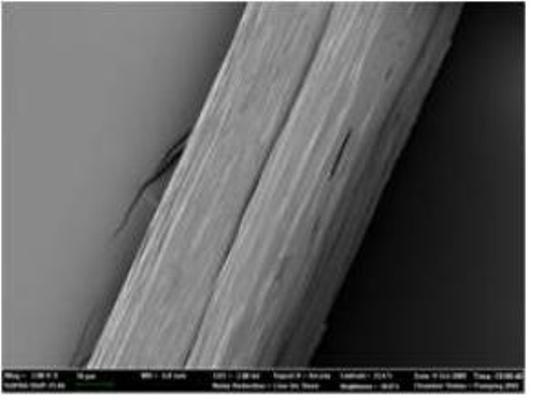 Native-like Spider Silk Produced in Metabolically Engineered Bacterium
Microscopic picture of 285 kilodalton recombinant spider silk fiber
Researchers have long envied spiders’ ability to manufacture silk that is light-weighted while as strong and tough as steel or Kevlar. Indeed, finer than human hair, five times stronger by weight than steel, and three times tougher than the top quality man-made fiber Kevlar, spider dragline silk is an ideal material for numerous applications. Suggested industrial applications have ranged from parachute cords and protective clothing to composite materials in aircrafts. Also, many biomedical applications are envisioned due to its biocompatibility and biodegradability.
Unfortunately, natural dragline silk cannot be conveniently obtained by farming spiders because they are highly territorial and aggressive. To develop a more sustainable process, can scientists mass-produce artificial silk while maintaining the amazing properties of native silk? That is something Sang Yup Lee at the Korea Advanced Institute of Science and Technology (KAIST) in Daejeon, the Republic of Korea, and his collaborators, Professor Young Hwan Park at Seoul National University and Professor David Kaplan at Tufts University, wanted to figure out. Their method is very similar to what spiders essentially do: first, expression of recombinant silk proteins; second, making the soluble silk proteins into water-insoluble fibers through spinning.
For the successful expression of high molecular weight spider silk protein, Professor Lee and his colleagues pieced together the silk gene from chemically synthesized oligonucleotides, and then inserted it into the expression host (in this case, an industrially safe bacterium Escherichia coli which is normally found in our gut). Initially, the bacterium refused to the challenging task of producing high molecular weight spider silk protein due to the unique characteristics of the protein, such as extremely large size, repetitive nature of the protein structure, and biased abundance of a particular amino acid glycine. “To make E. coli synthesize this ultra high molecular weight (as big as 285 kilodalton) spider silk protein having highly repetitive amino acid sequence, we helped E. coli overcome the difficulties by systems metabolic engineering,” says Sang Yup Lee, Distinguished Professor of KAIST, who led this project. His team boosted the pool of glycyl-tRNA, the major building block of spider silk protein synthesis. “We could obtain appreciable expression of the 285 kilodalton spider silk protein, which is the largest recombinant silk protein ever produced in E. coli. That was really incredible.” says Dr. Xia.
But this was only step one. The KAIST team performed high-cell-density cultures for mass production of the recombinant spider silk protein. Then, the team developed a simple, easy to scale-up purification process for the recombinant spider silk protein. The purified spider silk protein could be spun into beautiful silk fiber. To study the mechanical properties of the artificial spider silk, the researchers determined tenacity, elongation, and Young’s modulus, the three critical mechanical parameters that represent a fiber’s strength, extensibility, and stiffness. Importantly, the artificial fiber displayed the tenacity, elongation, and Young’s modulus of 508 MPa, 15%, and 21 GPa, respectively, which are comparable to those of the native spider silk.
“We have offered an overall platform for mass production of native-like spider dragline silk. This platform would enable us to have broader industrial and biomedical applications for spider silk. Moreover, many other silk-like biomaterials such as elastin, collagen, byssus, resilin, and other repetitive proteins have similar features to spider silk protein. Thus, our platform should also be useful for their efficient bio-based production and applications,” concludes Professor Lee.
This work is published on July 26 in the Proceedings of the National Academy of Sciences (PNAS) online.
2010.07.28 View 22102
Native-like Spider Silk Produced in Metabolically Engineered Bacterium
Microscopic picture of 285 kilodalton recombinant spider silk fiber
Researchers have long envied spiders’ ability to manufacture silk that is light-weighted while as strong and tough as steel or Kevlar. Indeed, finer than human hair, five times stronger by weight than steel, and three times tougher than the top quality man-made fiber Kevlar, spider dragline silk is an ideal material for numerous applications. Suggested industrial applications have ranged from parachute cords and protective clothing to composite materials in aircrafts. Also, many biomedical applications are envisioned due to its biocompatibility and biodegradability.
Unfortunately, natural dragline silk cannot be conveniently obtained by farming spiders because they are highly territorial and aggressive. To develop a more sustainable process, can scientists mass-produce artificial silk while maintaining the amazing properties of native silk? That is something Sang Yup Lee at the Korea Advanced Institute of Science and Technology (KAIST) in Daejeon, the Republic of Korea, and his collaborators, Professor Young Hwan Park at Seoul National University and Professor David Kaplan at Tufts University, wanted to figure out. Their method is very similar to what spiders essentially do: first, expression of recombinant silk proteins; second, making the soluble silk proteins into water-insoluble fibers through spinning.
For the successful expression of high molecular weight spider silk protein, Professor Lee and his colleagues pieced together the silk gene from chemically synthesized oligonucleotides, and then inserted it into the expression host (in this case, an industrially safe bacterium Escherichia coli which is normally found in our gut). Initially, the bacterium refused to the challenging task of producing high molecular weight spider silk protein due to the unique characteristics of the protein, such as extremely large size, repetitive nature of the protein structure, and biased abundance of a particular amino acid glycine. “To make E. coli synthesize this ultra high molecular weight (as big as 285 kilodalton) spider silk protein having highly repetitive amino acid sequence, we helped E. coli overcome the difficulties by systems metabolic engineering,” says Sang Yup Lee, Distinguished Professor of KAIST, who led this project. His team boosted the pool of glycyl-tRNA, the major building block of spider silk protein synthesis. “We could obtain appreciable expression of the 285 kilodalton spider silk protein, which is the largest recombinant silk protein ever produced in E. coli. That was really incredible.” says Dr. Xia.
But this was only step one. The KAIST team performed high-cell-density cultures for mass production of the recombinant spider silk protein. Then, the team developed a simple, easy to scale-up purification process for the recombinant spider silk protein. The purified spider silk protein could be spun into beautiful silk fiber. To study the mechanical properties of the artificial spider silk, the researchers determined tenacity, elongation, and Young’s modulus, the three critical mechanical parameters that represent a fiber’s strength, extensibility, and stiffness. Importantly, the artificial fiber displayed the tenacity, elongation, and Young’s modulus of 508 MPa, 15%, and 21 GPa, respectively, which are comparable to those of the native spider silk.
“We have offered an overall platform for mass production of native-like spider dragline silk. This platform would enable us to have broader industrial and biomedical applications for spider silk. Moreover, many other silk-like biomaterials such as elastin, collagen, byssus, resilin, and other repetitive proteins have similar features to spider silk protein. Thus, our platform should also be useful for their efficient bio-based production and applications,” concludes Professor Lee.
This work is published on July 26 in the Proceedings of the National Academy of Sciences (PNAS) online.
2010.07.28 View 22102 -
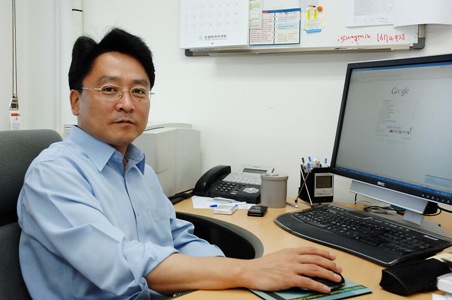 The thermal fluctuation and elasticity of cell membranes, lipid vesicles, interacting with pore-forming peptides were reported by a research team at KAIST.
A research team from KAIST, consisted of Sung-Min Choi, Professor of Nuclear and Quantum Engineering Department, and Ji-Hwan Lee, a doctoral student in the Department, published a paper on the “thermal fluctuation and elasticity of lipid vesicles interacting with pore-forming peptides.” The paper was carried by Physical Review Letters, an internationally renowned peer-review journal on physics on July 16, 2010.
Cell membranes, which consist of lipid bilayers, play important roles in cells as barriers to maintain concentrations and matrices to host membrane proteins. During cellular processes such as cell fission and fusion, the cell membranes undergo various morphological changes governed by the interplay between protein and lipid membranes. There have been many theoretical and experimental approaches to understand cellular processes driven by protein-lipid membrane interactions. However, it is not fully established how the membrane elastic properties, which play an important role in membrane deformation, are affected by the protein-membrane interactions.
Antimicrobial peptides are one of the most common examples of proteins that modify membrane morphology. While the pore-forming mechanisms of antimicrobial peptides in lipid bilayers have been widely investigated, there have been only a few attempts to understand the mechanisms in terms of membrane elastic properties. In particular, the effects of pore formation on the membrane fluctuation and elastic properties, which provide key information to understand the mechanism of antimicrobial peptide activity, have not been reported yet. The research team reports the thermal fluctuation and elasticity of lipid vesicles interacting with pore-forming peptides, which were measured by neutron spin-echo spectroscopy.
The results of this study are expected to pay an important role in understanding the elastic behavior and morphological changes of cell membranes induced by protein-membrane interactions, and may provide new insights for developing new theoretical models for membrane fluctuations which include the membrane mediated interaction between protein patches.
(a) (b)
Figure
(a) Schematics for bound melittin and pores in lipid bilayers
(b) P NMR signal ratio (with/without Mn2+) of DOPC LUV-melittin vs P/L at 30˚C. The dashed line is a guide for eyes.
2010.07.23 View 15045
The thermal fluctuation and elasticity of cell membranes, lipid vesicles, interacting with pore-forming peptides were reported by a research team at KAIST.
A research team from KAIST, consisted of Sung-Min Choi, Professor of Nuclear and Quantum Engineering Department, and Ji-Hwan Lee, a doctoral student in the Department, published a paper on the “thermal fluctuation and elasticity of lipid vesicles interacting with pore-forming peptides.” The paper was carried by Physical Review Letters, an internationally renowned peer-review journal on physics on July 16, 2010.
Cell membranes, which consist of lipid bilayers, play important roles in cells as barriers to maintain concentrations and matrices to host membrane proteins. During cellular processes such as cell fission and fusion, the cell membranes undergo various morphological changes governed by the interplay between protein and lipid membranes. There have been many theoretical and experimental approaches to understand cellular processes driven by protein-lipid membrane interactions. However, it is not fully established how the membrane elastic properties, which play an important role in membrane deformation, are affected by the protein-membrane interactions.
Antimicrobial peptides are one of the most common examples of proteins that modify membrane morphology. While the pore-forming mechanisms of antimicrobial peptides in lipid bilayers have been widely investigated, there have been only a few attempts to understand the mechanisms in terms of membrane elastic properties. In particular, the effects of pore formation on the membrane fluctuation and elastic properties, which provide key information to understand the mechanism of antimicrobial peptide activity, have not been reported yet. The research team reports the thermal fluctuation and elasticity of lipid vesicles interacting with pore-forming peptides, which were measured by neutron spin-echo spectroscopy.
The results of this study are expected to pay an important role in understanding the elastic behavior and morphological changes of cell membranes induced by protein-membrane interactions, and may provide new insights for developing new theoretical models for membrane fluctuations which include the membrane mediated interaction between protein patches.
(a) (b)
Figure
(a) Schematics for bound melittin and pores in lipid bilayers
(b) P NMR signal ratio (with/without Mn2+) of DOPC LUV-melittin vs P/L at 30˚C. The dashed line is a guide for eyes.
2010.07.23 View 15045 -
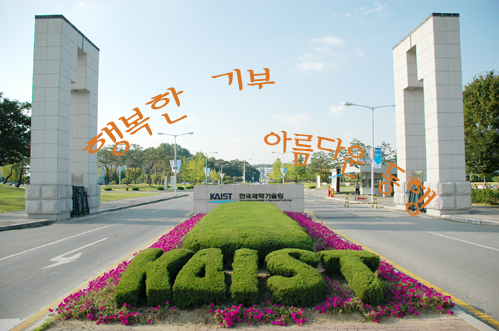 A stream of generous donations to KAIST continues to grow.
Yi-Won Oh is nothing but an ordinary person who lives in Seoul. Ever since retirement, she has looked into ways to donate her savings for a bigger cause that will benefit the people in need and the nation as a whole.
On the inauguration day of President Nam Pyo Suh who took his second term in office, Ms. Oh joined the ceremony and pledged to donate her savings to KAIST, which amounted to 10 billion won.
“I’ve always thought that the best way for our country to become a developed nation that lacks natural resources and has a small land is to develop science and technology by producing excellent manpower through a quality education. I talked to President Suh a couple of times, and we shared our common belief that the future of our nation hinges on the advancement of science and technology in Korea,” said Ms. Oh.
She added, “I support for President Suh’s vision and leadership, who has brought reformative and innovative changes to KAIST. I have no doubt that KAIST will become a leading research university in the world and play an important role in the development of our nation. It is indeed my pleasure that I can make announcement to donate my money to KAIST on the day President Suh is assigned to lead such a distinguished university one more time.”
KAIST plans to create and operate a fund dubbed “Yi-Won Oh Scholarship and Grant for Young Chair Professors.” Through the fund, talented students suffering financial difficulties and promising, young professors will have a richer opportunity to study and research.
2010.07.21 View 12135
A stream of generous donations to KAIST continues to grow.
Yi-Won Oh is nothing but an ordinary person who lives in Seoul. Ever since retirement, she has looked into ways to donate her savings for a bigger cause that will benefit the people in need and the nation as a whole.
On the inauguration day of President Nam Pyo Suh who took his second term in office, Ms. Oh joined the ceremony and pledged to donate her savings to KAIST, which amounted to 10 billion won.
“I’ve always thought that the best way for our country to become a developed nation that lacks natural resources and has a small land is to develop science and technology by producing excellent manpower through a quality education. I talked to President Suh a couple of times, and we shared our common belief that the future of our nation hinges on the advancement of science and technology in Korea,” said Ms. Oh.
She added, “I support for President Suh’s vision and leadership, who has brought reformative and innovative changes to KAIST. I have no doubt that KAIST will become a leading research university in the world and play an important role in the development of our nation. It is indeed my pleasure that I can make announcement to donate my money to KAIST on the day President Suh is assigned to lead such a distinguished university one more time.”
KAIST plans to create and operate a fund dubbed “Yi-Won Oh Scholarship and Grant for Young Chair Professors.” Through the fund, talented students suffering financial difficulties and promising, young professors will have a richer opportunity to study and research.
2010.07.21 View 12135